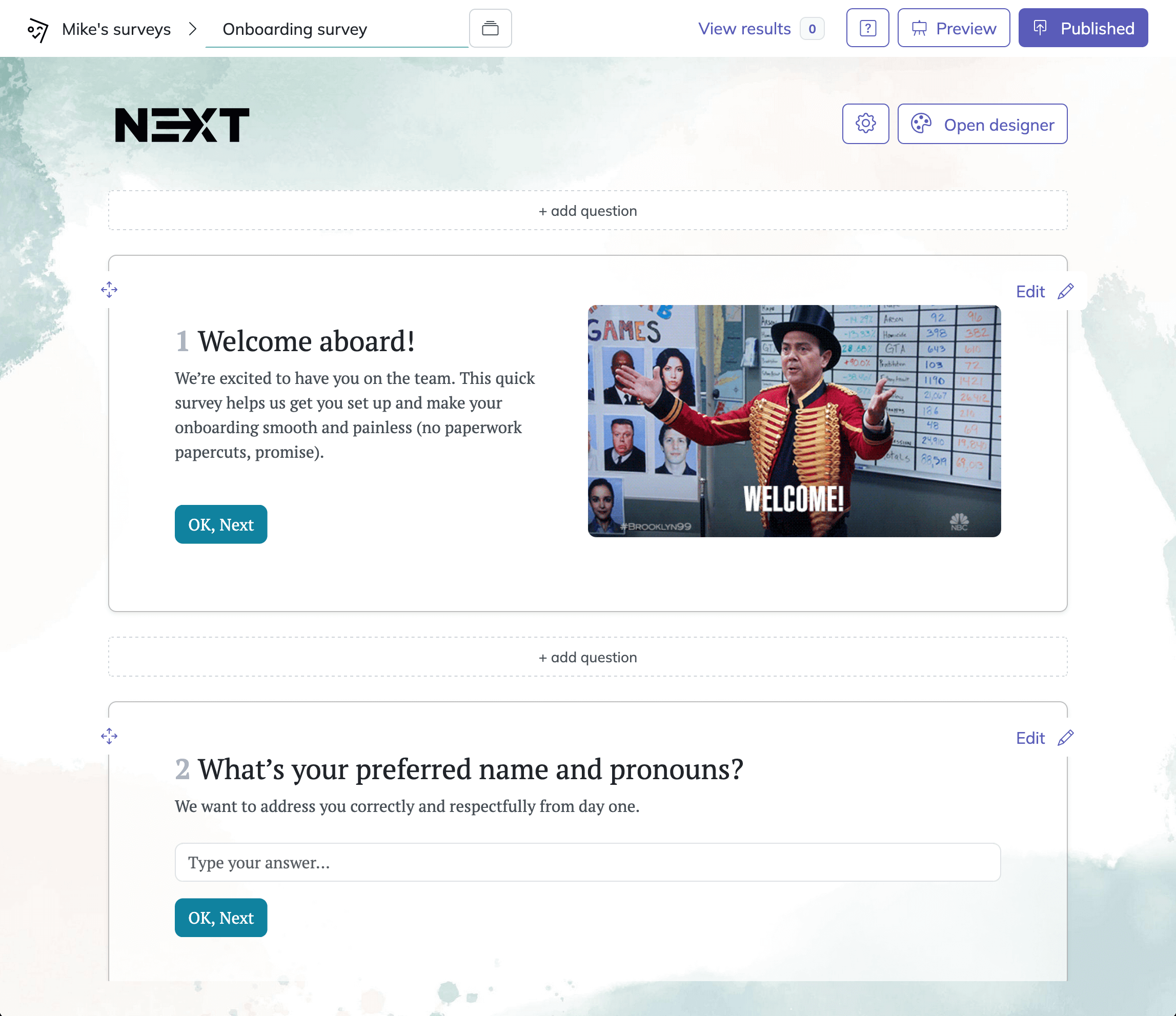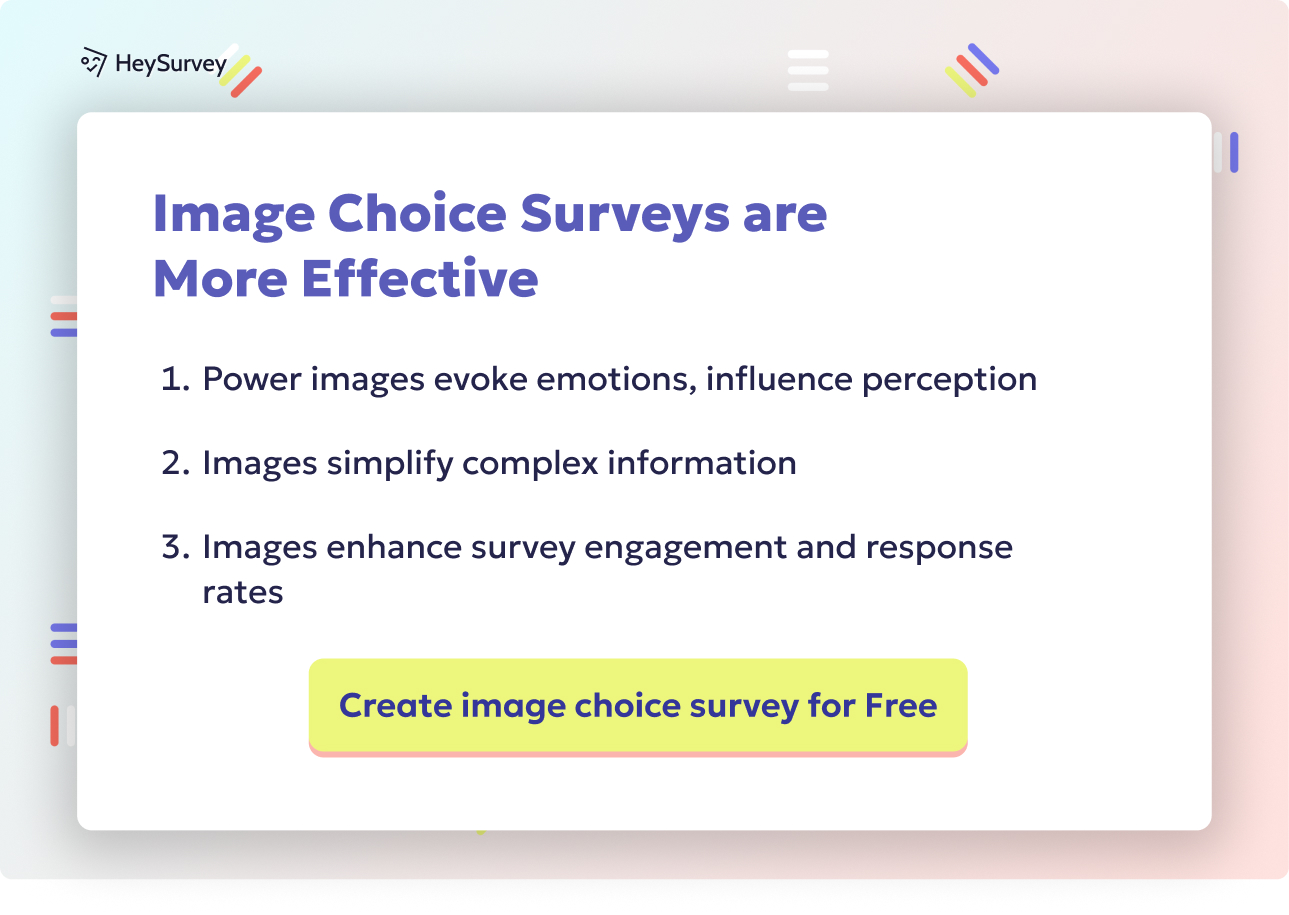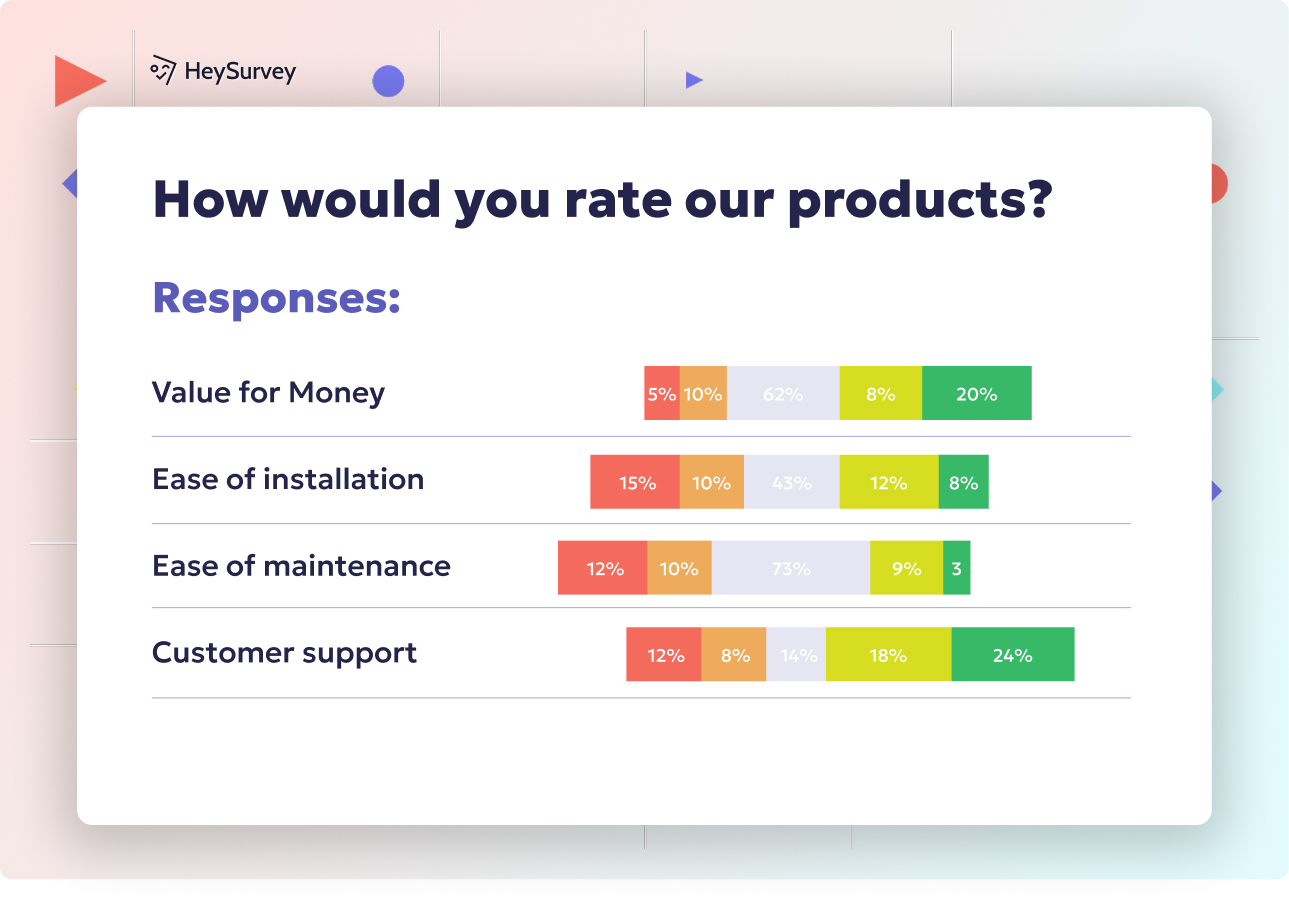32 Safety Survey Questions: Types, When & How to Use Them
Discover 30 expert safety survey questions across various types to boost workplace safety, culture, and compliance effectively.
Safety surveys are more than paperwork—they’re powerful tools that keep people from getting hurt, keep companies out of trouble, and create a culture where everyone goes home safe. Whether on a bustling factory floor or a quiet office, data from safety surveys reveals what’s working (and what’s not), nudging smarter decisions in training, resources, and safety policies. In this guide, we’ll break down the smartest survey types, reveal the when and why behind each, serve five juicy sample questions for every type, and hand you do’s and don’ts to make your safety surveys sparkle—no matter your industry turf.
Workplace Safety Climate Survey
Why & When to Use
Workplace safety climate surveys are the ultimate pulse check for safety on any job site. They gauge how safe (or not-so-safe) employees feel during their daily routines, shining a light on experiences that incident reports miss. Use these when you’re after the “big picture” safety vibe—think quarterly, annually, after a new policy rollout, or when accident rates suddenly spike.
If leadership claims safety is “priority one,” but staff sees things differently, this survey exposes that gap. It’s your chance to spot blind spots between management’s intentions and the frontline’s reality. You’ll want to deploy these: - When you suspect workers don’t feel safe speaking up. - After major organizational changes, to make sure safety isn’t sacrificed. - When planning new initiatives and need a safety baseline.
By tapping into honest, anonymous feedback, managers can tackle issues before they snowball. This survey’s insights inform decisions about training, communication, and those sometimes-missing safety meetings.
5 Sample Questions
On a scale of 1–10, how strongly do you feel management prioritizes safety over production deadlines?
How comfortable are you stopping work when you perceive an unsafe condition?
Do supervisors regularly recognize employees who follow safe practices? (Yes/No)
Rate the clarity of safety communication you receive (emails, briefings, signage).
What one change would most improve the overall safety climate here?
Employees who feel unsafe at work are nearly three times more likely to experience depressive symptoms and over twice as likely to report anxiety. (nsc.org)

Here’s how you can create your safety survey in just a few easy steps using HeySurvey. If you want to save time, you can also start by opening a ready-made template linked below these instructions.
Step 1: Create a New Survey
- Log in or start without an account on HeySurvey.
- Click “Create New Survey” and choose either “Empty Sheet” to start fresh or use a pre-built template for safety surveys.
- Give your survey an internal name (this is just for you to keep track).
Step 2: Add Questions
- Click the “Add Question” button to insert questions.
- Pick the question type that fits best: text, choice, scale, or others.
- Enter your safety survey questions, customize answer options (like scale 1–10, yes/no, or open-ended), and mark questions as required if needed.
- Duplicate or reorder questions to speed up the process.
Step 3: Publish Survey
- Click “Preview” to see how your survey looks and flows.
- When happy, hit “Publish”, which makes the survey live and generates a shareable link.
- Share this link with your team via email, intranet, or wherever is easiest.
Bonus Step A: Apply Branding
- Access the Designer Sidebar to add your logo, choose colors, fonts, and backgrounds that match your company’s look.
- Customize question cards, animations, and layout to create a polished, professional feel.
Bonus Step B: Define Settings or Skip into Branches
- Open the Settings Panel to:
- Set survey start/end dates or response limits.
- Create redirects for after completion.
- Choose whether respondents can see results (great for feedback loops).
- Set survey start/end dates or response limits.
- Use branching to tailor question paths based on answers—so respondents only see what’s relevant to them.
Feel free to click the button below to jump right into a tailored safety survey template and customize it to your needs!
Safety Training Effectiveness Survey
Why & When to Use
Safety training is only as good as what people actually remember and use. That’s where the safety training effectiveness survey jumps in. It gauges how much knowledge has genuinely stuck after a training session—and spots where you should focus next time.
Run this survey immediately after a training session, then again 30–90 days later to see what people retained. It’s perfect for checking if your fire extinguisher session was memorable or if staff can still recall your latest procedure. You’ll know exactly which modules to reinforce and how to tailor future safety programs.
This tool pinpoints: - Which concepts landed—and which fell flat. - Whether employees are acting differently since training. - Opportunities for extra practice or clearer instruction.
Using this feedback, training teams can revamp confusing modules, invest in high-impact topics, and boost the real-world ROI of every safety class.
5 Sample Questions
How confident are you that you can apply the lockout/tagout steps correctly?
Which part of the recent safety training was least clear?
Since the training, have you modified any unsafe behaviors? (Yes/No/Not applicable)
Rate the instructor’s ability to relate content to real-life scenarios.
What additional topics would you like covered in future sessions?
A systematic review found strong evidence that occupational health and safety training effectively changes worker behaviors, though its impact on health outcomes remains inconclusive. (pubmed.ncbi.nlm.nih.gov)
Incident Reporting & Near-Miss Survey
Why & When to Use
Incident and near-miss surveys are your secret weapon for uncovering hidden hazards. They don’t just measure how many reports you get—they explore what stops people from reporting and uncovers root causes nobody talks about.
Trigger this survey after introducing new reporting platforms or if you notice a suspicious drop in reported incidents. Low numbers might look great, but they could mean workers are scared, don’t have time, or simply don't know how to speak up.
The big wins for this survey: - Capture near-misses before they become real disasters. - Identify roadblocks like confusing forms or fear of reprisal. - Collect ideas to simplify or encourage reporting.
If people feel safe reporting mistakes, everyone wins—hazards get fixed, accidents drop, and safety culture thrives.
5 Sample Questions
How easy is it to submit an incident or near-miss report?
What prevents you from reporting some near-misses? (Select all that apply)
Do you believe reports lead to timely corrective action? (Yes/No/Unsure)
Have you ever experienced negative consequences after reporting? (Yes/No)
Suggest one improvement for the reporting process.
Personal Protective Equipment (PPE) Compliance Survey
Why & When to Use
Let’s face it: PPE only works when people use it (correctly, every time). The PPE compliance survey digs into the daily realities of goggles, gloves, vests, and more, shining a light on comfort, availability, and real-world use.
Deploy this before regulatory audits, after audits, or whenever introducing new PPE. It’s your best bet for uncovering whether inventory is stocked, if fit is off, or if there’s a reason safety glasses “get left behind.”
Use it to: - Track whether everyone has PPE handy for each task. - See if sizing, comfort, or maintenance is causing compliance headaches. - Identify chronic offenders or confusing rules.
This survey creates a fact base for audits and justifies investments in better PPE—because blisters and fogged goggles are a safety risk, too.
5 Sample Questions
Do you always have immediate access to the required PPE for your tasks? (Yes/No)
Rate the comfort and fit of your current PPE.
How often do you observe coworkers not wearing PPE correctly?
Have you reported defective or missing PPE in the past 30 days?
Which PPE item needs the most improvement?
A study found that 87% of safety professionals observed workers failing to wear required PPE, with discomfort cited as the primary reason. (ehstoday.com)
Safety Culture Perception Survey
Why & When to Use
Safety culture is deeper than rules and signage—it’s “how things are really done around here.” Use the safety culture perception survey to explore beliefs, values, and real buy-in from the boardroom to the break room.
Deploy these surveys yearly or after significant management shakeups. They go beneath the surface, detecting whether the glossy “Safety First” posters match what’s happening day to day.
This is essential for: - Discovering if leadership walks the talk. - Gauging whether peer pressure pushes staff toward or away from safety. - Finding holes between stated values and workplace reality.
Strong safety culture means safer actions, fewer shortcuts, and better teamwork—right from the top down.
5 Sample Questions
Safety is treated as a core organizational value here. (Strongly agree → Strongly disagree)
I trust leadership to act on safety concerns quickly.
Peer pressure encourages safe behavior on my team.
Resources for safety improvements are readily approved.
What cultural shift would make the biggest safety impact?
Ergonomics Risk Assessment Survey
Why & When to Use
Everyone’s joints, muscles, and backs are under siege if ergonomics are neglected—whether at a standing line or desk. The ergonomics risk assessment survey is your ticket to discovering hidden aches and strains before they turn into recordable injuries.
Perfect for workstation redesigns, new equipment rollouts, or rising injury rates, this survey gets to the bottom of: - Who’s feeling the pinch (or pull, or ache—literally). - Whether workstation layouts fit workers’ bodies. - If training or new equipment is needed for safe, comfortable work.
Musculoskeletal injuries can sideline even your best team members. By asking targeted questions, you’ll know where to adjust—and where to splurge on ergonomic fixes.
5 Sample Questions
How often do you experience discomfort in your neck, back, or wrists at work?
Can you easily adjust your workstation to fit your body?
Have you received ergonomic training in the last 12 months?
Rate the adequacy of mechanical aids (lift assists, adjustable tables).
Which task causes the greatest physical strain?
Contractor & Visitor Safety Survey
Why & When to Use
Contractors and visitors face unique risks—the “house rules” aren’t second nature. The contractor and visitor safety survey checks if your onboarding and site orientation actually protect non-employees.
Use this after every project, visit, or plant tour. It ensures all temporary guests understand where they can (and can’t) go, what PPE is required, and who to ask if things seem unsafe.
Survey advantages include: - Confirming orientation materials are clear (and not just legal jargon). - Checking if PPE was provided and hazards were obvious. - Capturing dangerous behavior and missteps witnessed on-site.
Investing in contractor and visitor safety not only protects your reputation, it ensures everyone under your roof gets the same quality of care.
5 Sample Questions
Was the site-specific safety orientation clear and concise?
Did you receive all required PPE upon arrival? (Yes/No)
Were site hazards adequately marked and communicated?
Did you witness any unsafe behaviors during your visit? (Yes/No)
How could the visitor safety process improve?
Commuter & Road Safety Survey
Why & When to Use
For many employees, the most dangerous part of the day is getting to and from work. The commuter and road safety survey puts a spotlight on off-site vehicle concerns—crucial for logistics teams, service techs, and anyone behind the wheel.
Run this survey after a jump in driving-related incidents, or at regular intervals for fleet-heavy businesses. Tip: This survey can slash accident rates, reduce insurance headaches, and keep workers on the job—not stuck in rehab.
It helps you find out: - How much time people spend driving for work. - If driver safety training is working or collecting dust. - The impact of scheduling pressures or deadline stress behind the wheel.
The open-ended feedback can uncover tech or support solutions nobody had considered—making every commute safer.
5 Sample Questions
How many hours per week do you drive for work purposes?
Do you regularly complete vehicle pre-trip inspections? (Always/Sometimes/Never)
Rate the effectiveness of driver safety training you’ve received.
How often do you feel pressured to speed to meet deadlines?
What technology or support would make your work-related driving safer?
Best Practices & Dos and Don’ts for Safety Surveys
Creating truly useful safety surveys is an art—master it with these practical dos and don’ts. The right approach means higher participation, more honest responses, and data you can actually use to save lives.
Do: - Anonymize responses to foster honesty and transparency. - Align survey timing and frequency with your safety KPIs. - Mix scaled, multiple-choice, and open-ended questions for rich data. - Keep completion under 10 minutes—nobody wants to write a novel at work! - Use mobile-friendly formats so people can respond on the go. - Translate surveys for multilingual teams to ensure every voice is heard. - A/B test subject lines and alerts to boost completion rates. - Always communicate action plans post-survey—let people see change as a result of their input.
Don’t: - Overload surveys with too many questions or complex wording. - Ignore survey results or delay acting on critical feedback. - Assume one survey fits every team—customize for your industry and risks. - Ask for names or identifying data unless absolutely necessary. - Send surveys at inconvenient times or before safety initiatives are communicated.
Remember: surveys only work when people trust they’ll bring real improvements. Celebrate wins, fix flaws, and always circle back with your team.
Review the suggested question sets in each section, tweak to match your context, and transform near-misses into future wins. Ultimately, safety surveys are your best sidekick for a safer, happier workplace. Now—go out there and listen!
Related Safety Survey Surveys

32 Crime Survey Questions: Types, Uses & Proven Examples
Explore 40 expertly crafted crime survey questions with sample sets to measure crime rates, publi...

31 Health and Safety Survey Questions: Types & Best Practices
Explore 35 expert health and safety survey questions across 7 types to boost workplace safety, em...

